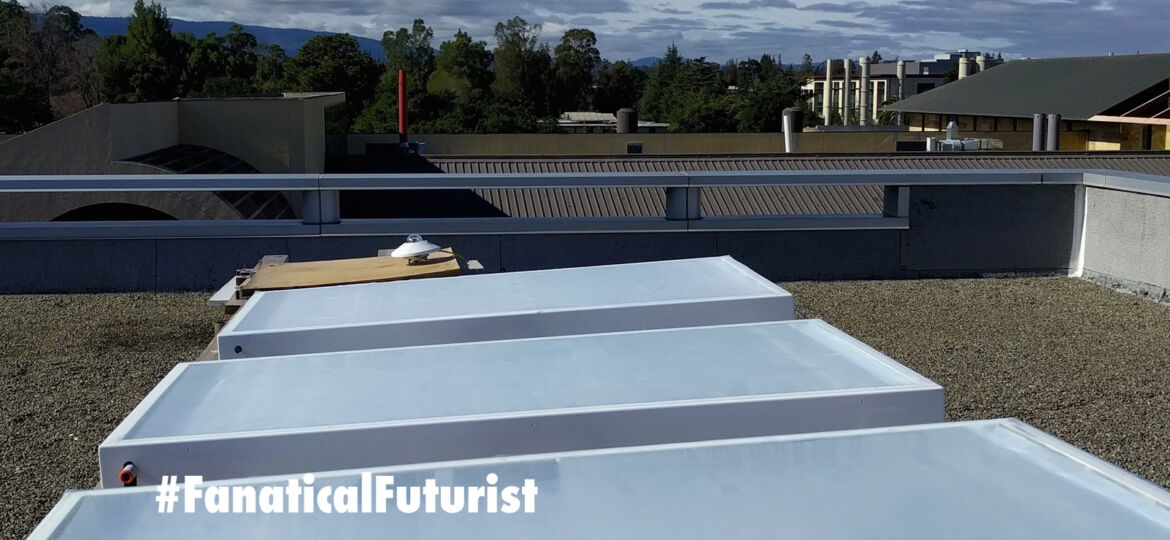
WHY THIS MATTERS IN BRIEF
Air conditioning that can cool buildings without using any energy is the holy grail of aircon, and now the technology’s arriving.
Heat naturally flows from hot things to cold things, it’s just a fact of life, and physics, and since there are few places colder than the vacuum of space, where the temperature is generally a nice warm and toasty -270C (-450F) it looks like that’s a great place to try to beam your excess heat to, and over the past few years that’s precisely what a team of researchers at Stanford University has been trying to do, and now they’ve developed a roof mounted system that can cool a building by doing just that, and that, as an added bonus doesn’t loose any water to boot.
In the latest version of their technology the team successfully managed to use their solar panel-like devices on the roof to cool water without needing an energy source. In short, it’s electricity free air con, and given the fact that air conditioning is generally thought to be responsible for using around 20 percent of all the energy used in the US it could be a big breakthrough in helping us reduce Carbon Dioxide emissions.
The Stanford system, which the team call Radiative Sky Cooling (RSC), because it radiates excess heat into space, first made its appearance in 2013 as a way of cooling homes and buildings without having to use any energy by drawing heat, directly from the buildings and emitting it into space at a wavelength, in the mid-range infrared part of the spectrum, that allowed it to easily pass through the Earth’s atmosphere.
“If you have something that is very cold – like space – and you can dissipate heat into it, then you can do cooling without any electricity or work,” says Shanhui Fan, senior author of the study, “the heat just flows [into space]. For this reason, the amount of heat flow off the Earth that goes to the universe is enormous.”
The technology even works on hot sunny days, which is probably a good thing if your using air con to cool your building or home in a hot country, because the team also found a way to coat their panels with a multilayer optical film that can reflect over 97 percent of the sunlight that hits it.
“With this technology, we’re no longer limited by what the air temperature is, because we’re only limited by something much colder: the sky and space,” added Fan.
The teams initial proof-of-concept tests were done using wafers of their new radiative material that were 8 inches (20 cm) wide, but those only demonstrated that the surface itself stayed cool, and next they put the new material to work as a coating for solar panels as a way to keep them cool in order to increase their efficiency.
Now though the team have scaled it up and they’ve managed to show that it can be a practical way to cool running water, which can then, for example, be piped through a building in order to cool it. In the most recent tests the team placed four panels of the reflective material measuring 2 sq ft (0.2 sq m) on a rooftop, with water flowing quickly through pipes beneath it and over three days the panels were able to consistently cool the water 3° to 5° C (5° to 9° F) lower than the ambient air.
Using the data gathered through those tests, the team then tested how well the panels would fare when trying to cool a two story office building in the hot, arid climate of Las Vegas, and, sure enough, they found the building, which was cooled by a traditional air conditioning system whose condenser was cooled by the new panels, was in fact cooled. Throughout the summer the panels cut the power needed to cool the building by more than 20 percent, a saving of about 14.3 MWh of electricity, and that day to day the savings varied between 18 percent and 50 percent.
“This research builds on our previous work with radiative sky cooling but takes it to the next level,” says Aaswath Raman, co-lead author of the study, “it provides for the first time a high fidelity technology demonstration of how you can use radiative sky cooling to passively cool a fluid and, in doing so, connect it with cooling systems to save electricity.”
To continue developing the system the researchers have now founded a company called SkyCool Systems and they’re currently working on ways to integrate the new technology into air conditioning and refrigeration systems, especially in the data center market where huge hyperscale server farms crank out gargantuan amounts of heat, so much so that in some cases companies like Facebook are building their new data centers in the Arctic, that then has to be cooled by even larger, energy hungry air conditioning systems.
The research was published in the journal Nature Energy.
















